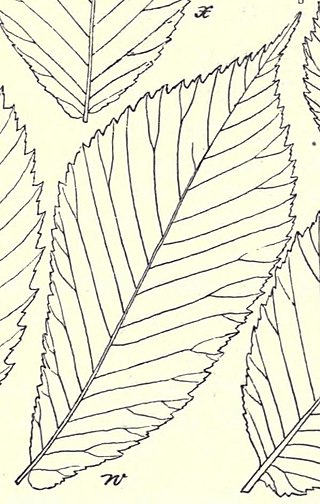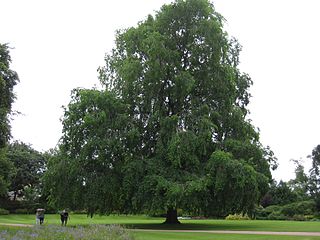
The hybrid elm cultivar Ulmus × hollandica 'Dampieri', one of a number of cultivars arising from the crossing of the Wych Elm U. glabra with a variety of Field Elm U. minor, is believed to have originated in continental Europe. It was marketed in Wetteren, Belgium, in 1851 as 'Orme de Dampier', then in the Low Countries in 1853, and later identified as Ulmus campestris var. nuda subvar. fastigiata DampieriHort., Vilv. by Wesmael (1862).

The Wych Elm cultivar Ulmus glabra 'Lutescens', commonly known as the Golden Wych Elm, arose as a sort of a wych found in the York area in the early 19th century by W. Pontey of Pontey's nursery, Kirkheaton, Huddersfield, who propagated and distributed it. The original tree he named the Gallows Elm for its proximity to a gallows near York. Loudon in The Gardener's Magazine (1839) identified it as a form of Ulmus montana, adding 'Lutescens' by analogy with Corstorphine sycamore, Acer pseudoplatanus 'Lutescens'.

Ulmus 'Exoniensis', the Exeter elm, was discovered near Exeter, England, in 1826, and propagated by the Ford & Please nursery in that city. Traditionally believed to be a cultivar of the Wych Elm U. glabra, its fastigiate shape when young, upward-curving tracery, small samarae and leaves, late leaf-flush and late leaf-fall, taken with its south-west England provenance, suggest a link with the Cornish Elm, which shares these characteristics.
The elm cultivar Ulmus 'Atropurpurea' [:dark purple] was raised from seed at the Späth nursery in Berlin, Germany, circa 1881, as Ulmus montana atropurpurea, and was marketed there till the 1930s, being later classed as a cultivar by Boom. Henry (1913) included it under Ulmus montana cultivars but noted that it was "very similar to and perhaps identical with" Ulmus purpureaHort. At Kew it was renamed U. glabraHuds. 'Atropurpurea', but Späth used U. montana both for wych elm and for some U. × hollandica hybrids, so his name does not necessarily imply a wych elm cultivar. The Hesse Nursery of Weener, Germany, however, which marketed 'Atropurpurea' in the 1950s, listed it in later years as a form of U. glabraHuds..

The elm cultivar Ulmus 'Purpurea', the purple-leaved elm, was listed and described as Ulmus Stricta Purpurea, the 'Upright Purpled-leaved Elm', by John Frederick Wood, F.H.S., in The Midland Florist and Suburban Horticulturist (1851), as Ulmus purpureaHort. by Wesmael (1863), and as Ulmus campestris var. purpurea, syn. Ulmus purpureaHort. by Petzold and Kirchner in Arboretum Muscaviense (1864). Koch's description followed (1872), the various descriptions appearing to tally. Henry (1913) noted that the Ulmus campestris var. purpureaPetz. & Kirchn. grown at Kew as U. montana var. purpurea was "probably of hybrid origin", Ulmus montana being used at the time both for wych elm cultivars and for some of the U. × hollandica group. His description of Kew's U. montana var. purpurea matches that of the commonly-planted 'Purpurea' of the 20th century. His discussion of it (1913) under U. campestris, however, his name for English Elm, may be the reason why 'Purpurea' is sometimes erroneously called U. procera 'Purpurea' (as in USA and Sweden.

The putative hybrid cultivar Ulmus × hollandica 'Serpentina' is an elm of unknown provenance and doubtful status. Henry identified it as intermediate between U. glabra and U. minor, a view accepted by Bean and by Melville, who believed that the specimens at Kew bearing the name 'Serpentina' were U. glabra "introgressed by U. carpinifolia" [: U. minor] and were similar to but "distinct from 'Camperdownii'".
The elm cultivar Ulmus 'Monstrosa' [: "monstrous", "strange"], a shrub-elm with fasciated branching, is believed to have originated in France, where it was first listed by Lavallée in Arboretum Segrezianum (1877) as a form of Field Elm, Ulmus campestris var. monstrosa, but without description. Though its long slender 2 cm petiole is not a feature of wych elm U. glabraHuds., and is even less likely in a shrub form of this species, the wych-cultivar error arose early, perhaps because the Späth nursery of Berlin, using Ulmus montana both for some Ulmus × hollandica cultivars and for wych varieties, listed it c.1890 as Ulmus montana monstrosa. Hartwig in Illustrirtes Gehölzbuch (1892) followed with Ulmus scabra monstrosa, an error repeated by Krüssman (1962) and by Green (1964), with their U. glabraHuds. 'Monstrosa'.
The Wych Elm cultivar Ulmus glabra 'Corylifolia Purpurea' was raised from seed of 'Purpurea' and described as U. campestris corylifolia purpurea by Pynaert in 1879. An U. campestris corylifolia purpurea was distributed by the Späth nursery of Berlin in the late 19th and early 20th centuries. The Hesse Nursery of Weener, Germany, corrected the U. campestris corylifolia purpurea of their 1930s' lists to U. glabraHuds.corylifolia purpurea by the 1950s. Green listed 'Corylifolia Purpurea' as a form of U. glabra.
The putative Wych Elm cultivar Ulmus glabra 'Dovaei', or Doué elm, was raised by the André Leroy nursery at Angers, France, as Ulmus dovaei, before 1868. The Baudriller nursery of Angers marketed it as Ulmus Dowei, "orme de Doué", suggesting a link with the royal nurseries at nearby Doué-la-Fontaine, which stocked elm. Green considered it a form of wych.
The putative Wych Elm cultivar Ulmus glabra 'Latifolia Nigricans' was first described, as Ulmus campestris latifolia nigricans, by Pynaert in 1879. Pynaert, however, did not specify what species he meant by U. campestris. The tree was supplied by the Späth nursery of Berlin in the late 19th century and early 20th as Ulmus montana latifolia nigricans. Späth, like many of his contemporaries, used U. montana both for Wych Elm cultivars and for those of the U. × hollandica group.

The putative Wych Elm cultivar Ulmus glabra 'Macrophylla' [literally 'long-leaved', though also 'large-leaved'] was first mentioned by Lavallée in 1877 as U. montana var. macrophylla (fastigiata). The Späth nursery of Berlin marketed an U. montana macrophylla in the late 19th and early 20th century; both Späth and the Hesse Nursery of Weener, Germany, supplied it in the 1930s. At that time, Ulmus montana was used both for wych elm cultivars and for hybrid cultivars of the Ulmus × hollandica group.

The dwarf wych elm cultivar Ulmus glabra 'Nana', a very slow growing shrub that with time forms a small tree, is of unknown origin. It was listed in the Simon-Louis 1869 catalogue as Ulmus montana nana. Henry (1913), referring his readers to an account of the Kew specimen in the journal Woods and Forests, 1884, suggested that it may have originated from a witch's broom. It is usually classified as a form of Ulmus glabra and is known widely as the 'Dwarf Wych Elm'. However, the ancestry of 'Nana' has been disputed in more recent years, Melville considering the specimen once grown at Kew to have been a cultivar of Ulmus × hollandica.
Ulmus × hollandica 'Pitteurs' or 'Pitteursii', one of a number of hybrid cultivars arising from the crossing of the Wych Elm Ulmus glabra with a variety of Field Elm Ulmus minor, was first identified by Morren as l'orme Pitteurs (1848). Elwes and Henry (1913) and Krüssmann (1976) listed it as an Ulmus × hollandica cultivar. It was named after the landowner Henri Bonaventure Trudon de Pitteurs of Saint-Trond, near Liège, Belgium, who discovered and first propagated the tree on his estate.

The hybrid elm cultivar Ulmus × hollandica 'Superba' is one of a number of intermediate forms arising from the crossing of the Wych Elm U. glabra with a variety of Field Elm U. minor. Boulger tentatively (1881) and Green more confidently (1964) equated it with a hybrid elm cultivated in the UK by Masters at Canterbury in the early 19th century, known as "Masters' Canterbury Seedling" or simply the Canterbury Elm. Loudon examined a specimen sent by Masters and considered it a hybrid, calling it U. montana glabra major.

The putative Wych Elm cultivar Ulmus glabra 'Latifolia' was identified in Audibert's Tonelle (1817) as U. campestrisLinn. [ = U. glabraHuds.] latifolia. The tree is reputed to have originated circa 1750 in or around Mechelen, and to have been widely planted throughout Belgium. A 1912 herbarium specimen from Oudenbosch, however, shows a hybrid leaf labelled Ulmus hollandica latifolia.
The elm cultivar Ulmus × hollandica 'Blandford' was listed by the Urban Forestry Administration (UFA) of the District Department of Transportation in Washington, D.C., as one of its 'street trees' in 2008. As the UFA has no further documentation to support it, the entry may be spurious, but it is most likely the tree is the wych elm cultivar Ulmus glabra 'Superba', known in the UK as the 'Blandford Elm' and introduced to the US in the early 20th century, or possibly the hybrid cultivar Ulmus × hollandica 'Superba' present in some American collections, including Garfield Park, Washington, D.C., in the mid-20th century.

Ulmus × hollandica 'Wentworthii Pendula', commonly known as the Wentworth Elm or Wentworth Weeping Elm, is a cultivar with a distinctive weeping habit that appears to have been introduced to cultivation towards the end of the 19th century. The tree is not mentioned in either Elwes and Henry's or Bean's classic works on British trees. The earliest known references are Dutch and German, the first by de Vos in Handboek tot de praktische kennis der voornaamste boomen (1890). At about the same time, the tree was offered for sale by the Späth nursery of Berlin as Ulmus Wentworthi pendulaHort.. The 'Hort.' in Späth's 1890 catalogue, without his customary label "new", confirms that the tree was by then in nurseries as a horticultural elm. De Vos, writing in 1889, states that the Supplement to Volume 1 includes entries announced since the main volume in 1887, putting the date of introduction between 1887 and 1889.

The hybrid elm cultivar Ulmus × hollandica 'Fastigiata' was first listed and described as Ulmus glabra fastigiata, a narrow-crowned elm with large smooth leaves, by Petzold and Kirchner in Arboretum Muscaviense (1864). C. Berndt of the Berndt Nursery, Zirlau, Schweidnitz, described an elm of the same name in Mitteilungen der Deutschen Dendrologischen Gesellschaft, that he had received in 1903 "from a renowned nursery in Holstein" as Ulmus montana fastigiata macrophylla. A tree of that name had been listed by Dieck in 1885 without description. Berndt reported that his U. glabra fastigiata was "easy to confuse with U. montana superba", a tree "known in the Magdeburg region as Ulmus praestans", a statement confirming that, like that cultivar, his tree was a form of U. × hollandica. Karl Gustav Hartwig who received specimens of U. praestans from Kiessling of the Magdeburg city nursery in 1908, concluded (1912) that U. glabra fastigiataKirchner was indistinguishable in leaf or habit from U. praestans. An U. campestris glabra fastigiataArb. Musc. [ = Kirchner] was distributed by the Hesse Nursery, Weener, Germany, in the 1930s, where it was listed separately from U. praestans.

The elm cultivar Ulmus 'Fastigiata Glabra' was distributed by the Späth nursery, Berlin, in the 1890s and early 1900s as U. montana fastigiata glabra. Späth used U. montana both for cultivars of wych elm and for those of some U. × hollandica hybrids like 'Dampieri'. A specimen of U. montana fastigiata glabra in the Royal Botanic Garden Edinburgh was determined by Melville in 1958 as a hybrid of the U. × hollandica group.

The Wych Elm cultivar Ulmus glabra 'Concavaefolia', a form with up-curling leaves, was listed in Beissner's Handbuch der Laubholz-Benennung (1903) as Ulmus montana cucullataHort. [:'hooded', the leaf], a synonym of the Ulmus scabraMill. [:glabraHuds.] var. concavaefolia of herbarium specimens. An Ulmus campestris cucullata, of uncertain species, had appeared in Loddiges' 1823 list, but Loudon's brief description (1838) of concave- and hooded-leaved elms was insufficient for later botanists to distinguish them. The earliest unambiguous description appears to be that of Petzold and Kirchner in Arboretum Muscaviense (1864).




















